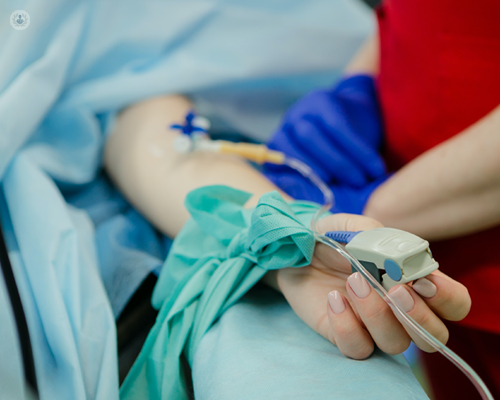Carpal tunnel syndrome article series: Surgery and what’s involved
Written by:When the median nerve, a major nerve in our wrist, is compressed, it can lead to discomfort and disrupt everyday routines due to its’ symptoms. More seriously, it can lead to permanent nerve damage if it goes untreated.
Renowned consultant orthopaedic surgeon Miss Samantha Tross speaks to Top Doctors for a three-part series about this common and sometimes debilitating, yet treatable, condition. In this article, she goes into expert detail about what’s involved in surgery for carpal tunnel syndrome.

How do people with carpal tunnel syndrome prepare for surgery?
Surgery can be carried out under local anaesthetic or general anaesthetic. We try to encourage patients to have the surgery performed under local anaesthetic because that way you avoid all of the complications of general anaesthetic and you can get home faster.
To perform the surgery, local anaesthetic with adrenaline (to constrict the blood vessels and prevent bleeding) is injected in and around the area that we plan to operate (wrist and palm). Numbness then ensues in the fingers (except little finger) and palm, which may persist for some hours after the procedure. During the surgery patients may experience the sensation of pressure but should not experience pain, if the anaesthetic is working well.
If you're having a general anaesthetic, some preparation is required beforehand, such as fasting.
For both local and general anaesthetic carpal tunnel procedures, you may be required to withhold your medication e.g., aspirin or any medication that may increase bleeding, such as warfarin. If bleeding is not controlled, you may bleed excessively into the surgical wound, which may itself put pressure on the nerve and symptoms may recur. It's also important before surgery to keep your fingers moving as much as possible. This should be gently continued after surgery to prevent finger stiffness.
Are there risks involved in carpal syndrome surgery?
One risk of surgery is infection. In addition to bacterial infection, these days we also talk about COVID infection. Whilst every precaution is taken, we can't give a 100 per cent guarantee that you won't get infected. The risk of developing a bacterial wound infection, if you are otherwise fit and well, is less than one per cent. There is also risk of injury to the median nerve and the tendons that bend the fingers as you're releasing the band of tissue above them to perform this operation. Having a bloodless field minimises this risk of injuries to these structures.
If the adrenaline injected into the wound in the anaesthetic mixture is insufficient to prevent excessive bleeding, then a tourniquet can be used. A tourniquet is an inflated cuff that you put on the arm which then compresses the blood vessels to stop any bleeding. As there is no anaesthetic in the area constricted by the tourniquet, you will begin to experience discomfort if it remains elevated for a prolonged period. Fortunately, this is often not required, nor is the procedure usually prolonged.
If the patient is having a general anaesthetic, there are no concerns with the use of a tourniquet.
A branch of that median nerve arises before it enters the carpal tunnel, which supplies sensation to skin at the base of the thumb. This nerve usually arises away from the incision site. Anatomic anomalies can occur where the nerve passes across the standard incision site. If this occurs and the nerve is injured, patients may experience numbness in the skin at the base of the thumb. As this is a sensory nerve, there would be no impairment in the function of the thumb.
Patient’s scars tend to heal without any problems within two weeks. Occasionally these scars are tender and sensitive. This sensitivity can last up to three months. This is an important consideration for people who may perform regular tasks where pressure is applied to their palm. Patients may also experience hypo or hyperpigmentation of the scar in this area.
Another risk is reoccurrence of the condition. Sometimes, some people form aggressive scar tissue in the area operated on and this can lead to reoccurrence of the condition.
Entrapment of nerves in the neck can result in symptoms very similar to carpal tunnel syndrome. Sometimes this condition co-exists with carpal tunnel syndrome. If so, release of the carpal tunnel by itself will not lead to complete symptomatic relief. Hence part of surgical work up is to explore whether symptoms are due to carpal tunnel syndrome alone or another co-existing cause. Investigations such a nerve conduction studies and electromyography previously mentioned, will assist with this.
What happens after surgery for carpal tunnel syndrome?
The hand will be dressed with a waterproof padded-film dressing on the skin followed by wool and a crepe bandage. The limb will be immobilised in a polysling.
Wound stitches will be removed usually by the GP practice nurse at ten to fourteen days. Subsequently, I will review the patient in the outpatient department at six weeks.
To find out more, you can read Miss Tross’ introduction to carpal tunnel syndrome in part one and her article about treatment, and diagnosis of the condition in part two.
If you’re interested in Miss Tross’ top-class treatment for carpal tunnel syndrome and other orthopaedic conditions, visit her Top Doctors profile to make an appointment, here.



